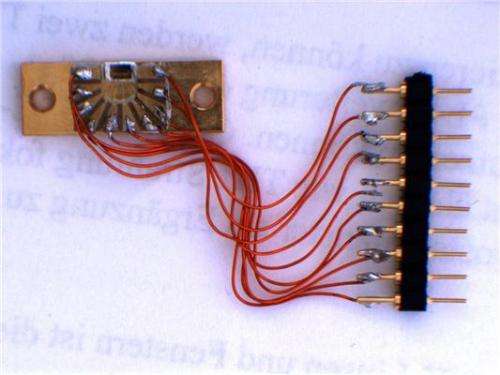New quantum-cascade laser operates at significantly higher temperatures than previously

For the observation of cold matter in the interstellar medium, astronomers need instruments for the detection of terahertz radiation. Specific high-resolution instruments are based on terahertz quantum-cascade lasers, but operate only at cryogenic temperatures. Physicists of the Paul Drude Institute (PDI) in Berlin, Germany, have now developed a terahertz quantum-cascade laser, which operates at significantly higher temperatures than previously achieved. The new development allows for the use of more compact cooling systems—also reducing the obstacles for many other applications.
The wavelengths of terahertz radiation lie between the microwave and infrared range. It penetrates many materials such as plastics and clothes. At the same time, terahertz radiation is—due to its small energy—non-ionizing and not dangerous for people. Applications of terahertz radiation include non-destructive material testing and safety checks at airports.
For astronomers, terahertz radiation provides new insights in the investigation of so-called cold matter. This kind of matter does not emit visible light such as the stars, but electromagnetic radiation in the infrared to microwave range. The German Aerospace Center (DLR) measures such emission lines with high precision within the US-German SOFIA project. Due to the Doppler shift of the detected frequencies, the researchers can determine the velocity of the motion of cold matter through the galaxy. To reduce the absorption by water in the earth atmosphere, the measurements are carried out from an airplane. One key element of the detector system is a quantum-cascade laser developed at the PDI.
In a joint project funded by the Investitionsbank Berlin, the researchers have developed a compact quantum-cascade laser system. The partners in this project were in addition to the PDI the Ferdinand Braun Institute in Berlin, the Humboldt University in Berlin, and the company eagleyard Photonics located also in Berlin.
"One problem of the lasers are the low operating temperatures, which are typically even below the temperature of liquid nitrogen of 77 Kelvin or -196 °C for continuous-wave operation", explains Martin Wienold from the PDI. "We achieved a new record: our lasers operate up to 129 Kelvin (-144 °C) improving the previous record by more than 10 degrees." This is still rather cold, "but, in combination with a significantly reduced power dissipation of the new lasers, it allows for the use of much smaller mechanical coolers. Thereby, we will be able to reduce the size of systems based on terahertz quantum-cascade lasers in the future—an important point for flight missions such as SOFIA", Wienold emphasizes.
The physicists at the PDI achieved the high operating temperatures by developing a semiconductor heterostructure, which requires only a very low driving power. The laser ridge is only about 10-15 microns high and 15 microns wide, while the emission wavelength is about 100 microns. The active region is confined by two metal layers, which are almost perfect mirrors in the terahertz range. This combination results in very low power dissipation and operation at low current densities and voltages.
"However, there has been an additional problem", explains Martin Wienold: "We achieved relatively high operating temperatures, but the strong spatial confinement of the light in the laser resulted in an extremely divergent beam profile". The physicists solved the problem by applying a concept from the early days of radio broadcasting. A grating on top of the laser ridge—a so-called third-order grating—acts as a directive antenna, which collimates the laser emission. "We are currently working on achieving even higher operating temperatures", says Wienold. "However, room temperature operation will become difficult to achieve because of some physical limits."
Quantum-cascade laser
Quantum-cascade lasers differ from common diode lasers by its structure and the involved physical processes. Typical diode lasers emit light, when electrons from the conduction band recombine with holes from the valence band. Upon recombination, a photon is emitted with the energy of approximately the semiconductors energy gap. Since the energy gap is determined by the used semiconductor material, the wavelength of a diode laser is basically determined by the material.
In a quantum-cascade laser, the electron remains in the conduction band, and the laser transitions takes place between two confined subband states within the conduction band. This performance is achieved by alternating extremely thin semiconductor layers, resulting in so-called potential wells in the conduction band. When an electric field is applied, the electrons move from an energetically higher lying potential well to an energetically lower lying potential well via the quantum mechanical tunneling effect. The electrons tumble down from one potential well to the next potential well in such a way, as falling down a staircase.
More information:
"High-temperature, continuous-wave operation of terahertz quantum-cascade lasers with metal-metal waveguides and third-order distributed feedback." M. Wienold, B. Röben, L. Schrottke, R. Sharma, A. Tahraoui, K. Biermann, and H. T. Grahn. Optics Express, Vol. 22, Issue 3, pp. 3334-3348 (2014)
dx.doi.org/10.1364/OE.22.003334
Journal information: Optics Express
Provided by Forschungsverbund Berlin e.V. (FVB)




















